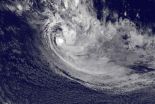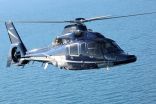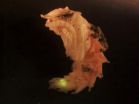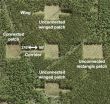(Press-News.org) NOAA's GOES-West satellite caught the birth of Tropical Storm Mike in the Southern Pacific Ocean on March 19. Mike's formation has generated warnings for the Southern Cook Islands.
NOAA's GOES-West or GOES-15 satellite captured an infrared image of newborn Tropical Storm Mike in the Southwestern Pacific Ocean on March 19 at 1200 UTC/8 a.m. EDT. Mike appeared to be a compact, rounded tropical storm with bands of thunderstorms wrapping into it. NOAA's GOES-West satellite sits in a fixed orbit in space capturing visible and infrared imagery of all weather over the western U.S. and Pacific Ocean.
To create a GOES image NASA/NOAA's GOES Project at NASA's Goddard Space Flight Center in Greenbelt, Md. uses cloud data from NOAA's GOES-East satellite and overlays it on a true-color image of land and ocean created by data from the Moderate Resolution Imaging Spectroradiometer, or MODIS, instrument that flies aboard NASA's Aqua and Terra satellites. Together, those data create the picture of the weather over the Pacific Ocean and Tropical Cyclone Mike's location.
According to the Joint Typhoon Warning Center or JTWC, animated infrared satellite imagery showed that the consolidated low level circulation center has persistent central convection (developing thunderstorms) and broken displaced convection to the northwest and southeast of the center.
On March 19 at 0900 UTC/5 a.m. EDT, Tropical Cyclone Mike was located near 20.5 south latitude and 159.3 west longitude. That's about 751 nautical miles/864.2 miles/1,391 miles east-southeast of Pago Pago, American Samoa. Mike was moving to the south-southeast at a speedy 24 knots/27.6 mph/44.4 kph. Mike's maximum sustained winds were near 35 knots/40 mph/62 kph.
JTWC noted that Mike is a threat to the Cook Islands. As a result, there are warnings in effect for the Southern Cook Islands. A gale warning is in effect for Rarotonga, Aitutaki, Manuae, Takutea, Atiu, Matiaro, Mauke and Mangaia.
JTWC forecasters expect Mike to move quickly to the south-southeast and strengthen to 45 knots/51.7 mph/83.3 kph before running into conditions that will make it extra-tropical in two days.
INFORMATION:
Text credit: Rob Gutro
NASA's Goddard Space Flight Center
Satellite sees newborn So. Pacific Tropical Storm Mike
2014-03-19
ELSE PRESS RELEASES FROM THIS DATE:
The scientific legacy of colonialism in Africa
2014-03-19
Colonial legacy has a significant impact on scientific productivity across the continent of Africa, according to a study by researchers at the University of Lomé, in Togo. Writing in the International Journal of Education Economics and Development, the team suggests that Africa performs relatively poorly compared with other regions of the world. Moreover, their analysis of data for the period 1994 to 2009 shows that African nations with a British colonial legacy are much more productive than countries with French or other history. This, the team adds, correlates with superior ...
French Alps Property Market Witnesses a Surge in Interest From International Buyers
2014-03-19
Demand for property in the Alps is on the increase with a growing number of foreigners looking to invest in resorts such as Chamonix, according to new figures.
Property agents in Chamonix, a resort in France's Savoie region and one of the key Alpine winter destinations, are reporting soaring property demand, much of which is being driven by the international buyers. The real estate agents also revealed an increase in property prices of more than eight per cent during 2013. This surge in interest can be attributed to the infrastructure upgrades in Chamonix and also to ...
Catching the early spread of breast cancer
2014-03-19
DALLAS, March 19, 2014 — When cancer spreads from one part of the body to another, it becomes even more deadly. It moves with stealth and can go undetected for months or years. But a new technology that uses "nano-flares" has the potential to catch these lurking, mobilized tumor cells early on. Today, scientists presented the latest advances in nano-flare technology as it applies to the detection of metastatic breast cancer cells.
The report was one of more than 10,000 at the 247th National Meeting & Exposition of the American Chemical Society (ACS). The meeting is taking ...
Noninvasive colorectal cancer screening tool shows unprecedented detection rates
2014-03-19
ROCHESTER, Minn. — March 17, 2014 — Results of a clinical trial of Cologuard show unprecedented rates of precancer and cancer detection by a noninvasive test. The detection rates are similar to those reported for colonoscopy. The results were published in the March 20 issue of the New England Journal of Medicine (NEJM). Cologuard was co-developed by Mayo Clinic and Exact Sciences.
Cologuard, is a noninvasive sDNA test for the early detection of colorectal precancer and cancer. The Cologuard test is based on a stool sample that is analyzed for DNA signatures of precancer ...
New, noninvasive, stool-based colorectal cancer screening test
2014-03-19
(New York, March 19, 2014) – A new, non-invasive, stool-based screening test detected 92% of colorectal cancer (CRC), according to a multicenter trial published online today in the New England Journal of Medicine. The new test, which is not yet approved by the FDA, allows patients to collect a sample at home without the need for bowel preparation or diet restrictions.
Unlike other available stool-based CRC screening tests, which rely solely on detecting occult blood in the stool, this new test, called "Cologuard", developed and patented by Exact Sciences, detects both ...
Work shines light on Hox genes responsible for firefly lantern development
2014-03-19
It's difficult to identify a single evolutionary novelty in the animal kingdom that has fascinated and intrigued mankind more than the lantern of the firefly. Yet to this day, nothing has been known about the genetic foundation for the formation and evolution of this luminescent structure.
But now, new work from a former Indiana University Bloomington graduate student and his IU Ph.D. advisor offers for the first time a characterization of the developmental genetic basis of this spectacular morphological novelty -- the firefly's photic organ -- and the means by which this ...
Winners and losers in globalization of world's economy, health and education
2014-03-19
Globalization has made the world a better and more equal place for many more people than was the case a few decades ago. However, it has also created two well-defined worlds of poor countries and wealthy nations, according to Vanesa Jordá and José María Sarabia of the University of Cantabria in Spain. In an article published in Springer's journal Applied Research in Quality of Life, they studied the distribution of well-being over the last wave of globalization between 1980 and 2011.
Well-being is generally described as the state of being happy, healthy or prosperous. ...
Magnetic behavior discovery could advance nuclear fusion
2014-03-19
ANN ARBOR—Inspired by the space physics behind solar flares and the aurora, a team of researchers from the University of Michigan and Princeton has uncovered a new kind of magnetic behavior that could help make nuclear fusion reactions easier to start.
Fusion is widely considered the ultimate goal of nuclear energy. While fission leaves behind radioactive waste that must be stored safely, fusion generates helium, a harmless element that is becoming scarce. Just 250 kilograms of fusion fuel can match the energy production of 2.7 million tons of coal.
Unfortunately, it ...
Increased risk of relapse omitting RT in early PET scan negative Hodgkin lymphoma
2014-03-19
Interim analysis of the intergroup EORTC-LYSA-FIL 20051 H10 trial published in the Journal of Clinical Oncology indicates an increased risk of early relapse when omitting radiotherapy in early PET scan negative patients with stage I/II Hodgkin's lymphoma. Early outcome, however, was excellent in both arms, and the final analysis should reveal whether these initial findings are maintained over time.
Dr. J.M.M. Raemaekers of the Radboud university medical center Nijmegen, The Netherlands, and central coordinator of the study says, "The standard treatment for patients with ...
Study finds forest corridors help plants disperse their seeds
2014-03-19
A forest in South Carolina, a supercomputer in Ohio and some glow-in-the-dark yarn have helped a team of field ecologists conclude that woodland corridors connecting patches of endangered plants not only increase dispersal of seeds from one patch to another, but also create wind conditions that can spread the seeds for much longer distances.
The idea for the study emerged from modern animal conservation practices, where landscape connectivity – the degree to which landscapes facilitate movement – is being used to counteract the impacts of habitat loss and fragmentation ...



